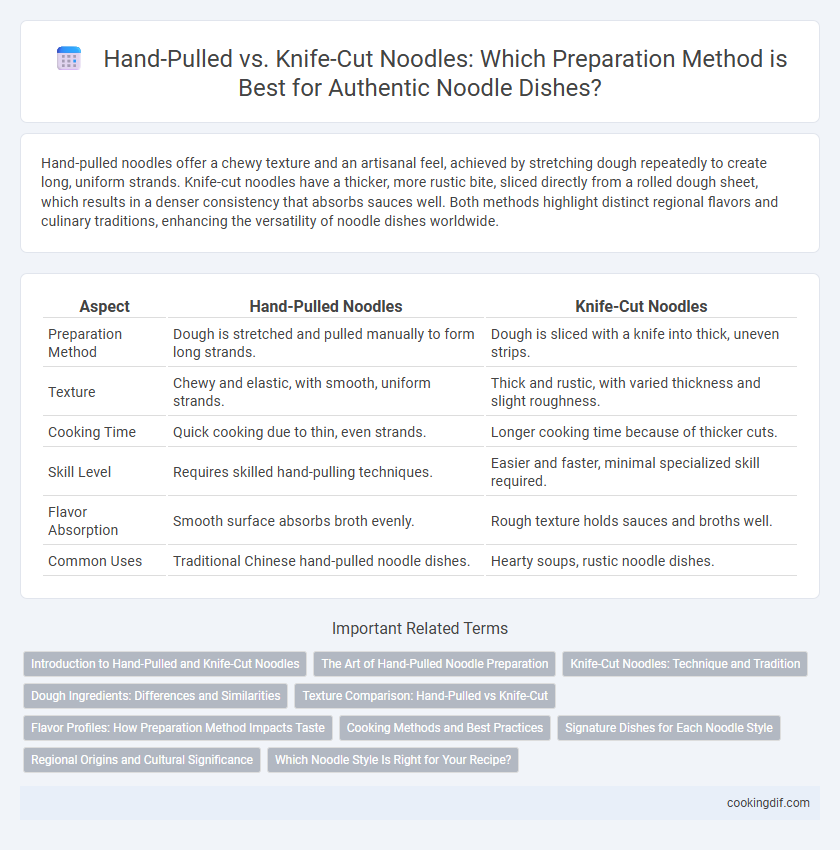Hand-pulled noodles offer a chewy texture and an artisanal feel, achieved by stretching dough repeatedly to create long, uniform strands. Knife-cut noodles have a thicker, more rustic bite, sliced directly from a rolled dough sheet, which results in a denser consistency that absorbs sauces well. Both methods highlight distinct regional flavors and culinary traditions, enhancing the versatility of noodle dishes worldwide.
Table of Comparison
| Aspect | Hand-Pulled Noodles | Knife-Cut Noodles |
|---|---|---|
| Preparation Method | Dough is stretched and pulled manually to form long strands. | Dough is sliced with a knife into thick, uneven strips. |
| Texture | Chewy and elastic, with smooth, uniform strands. | Thick and rustic, with varied thickness and slight roughness. |
| Cooking Time | Quick cooking due to thin, even strands. | Longer cooking time because of thicker cuts. |
| Skill Level | Requires skilled hand-pulling techniques. | Easier and faster, minimal specialized skill required. |
| Flavor Absorption | Smooth surface absorbs broth evenly. | Rough texture holds sauces and broths well. |
| Common Uses | Traditional Chinese hand-pulled noodle dishes. | Hearty soups, rustic noodle dishes. |
Introduction to Hand-Pulled and Knife-Cut Noodles
Hand-pulled noodles, known for their elastic texture, are crafted by stretching and folding dough repeatedly to achieve long, uniform strands. Knife-cut noodles feature a distinct rustic appeal, created by slicing a solid dough block directly into boiling water, resulting in thicker, irregular strands. Both techniques showcase unique textures and flavors that highlight traditional Asian noodle craftsmanship.
The Art of Hand-Pulled Noodle Preparation
Hand-pulled noodles showcase an ancient culinary technique requiring precise dough elasticity and expert skill to stretch and fold the dough repeatedly, creating long, uniform strands with a chewy texture. This artisanal process enhances the noodle's mouthfeel and absorbs broth flavors more effectively compared to knife-cut noodles, which have a denser bite due to their thicker, uneven cuts. Mastery of hand-pulling demands controlled wrist motion and perfect dough hydration, distinguishing it as a revered practice in traditional Chinese cuisine.
Knife-Cut Noodles: Technique and Tradition
Knife-cut noodles, a traditional Chinese technique, involve thinly slicing dough directly into boiling water, creating irregular, chewy strands prized for their hearty texture. This method requires skillful wrist control and precise dough consistency to ensure uniform thickness and optimal cooking. The rustic quality of knife-cut noodles highlights the artisanal craftsmanship unique to regional noodle-making traditions.
Dough Ingredients: Differences and Similarities
Hand-pulled and knife-cut noodles share core dough ingredients such as wheat flour, water, and salt, ensuring a similar base texture and flavor profile. The dough for hand-pulled noodles often requires higher gluten content flour and additional resting time to develop elasticity for stretching, while knife-cut noodle dough tends to be firmer, allowing precise slicing without deformation. Both methods balance ingredient ratios to achieve optimal chewiness and cooking performance, but the gluten strength and hydration levels are adjusted according to the preparation technique.
Texture Comparison: Hand-Pulled vs Knife-Cut
Hand-pulled noodles exhibit a chewy, elastic texture due to the stretching process, which aligns gluten strands and creates a springy bite. Knife-cut noodles tend to have a denser, more uneven surface texture, offering a slightly firmer chew and better sauce absorption. Texture preference depends on dish type, with hand-pulled noodles favored in soups for their softness and knife-cut noodles chosen for stir-fries or hearty broths.
Flavor Profiles: How Preparation Method Impacts Taste
Hand-pulled noodles develop a chewy texture and absorb broths and sauces deeply, resulting in a rich, nuanced flavor profile. Knife-cut noodles retain a firm bite and provide a slightly rustic taste due to their uneven, thicker edges that hold seasoning well. The method of preparation directly influences the noodle's mouthfeel and its ability to blend with accompanying ingredients, enhancing overall taste experience.
Cooking Methods and Best Practices
Hand-pulled noodles require skillful stretching and folding, resulting in a chewy texture with uneven thickness that enhances sauce absorption, while knife-cut noodles offer uniform thickness and a firmer bite due to their straight cuts. For hand-pulled noodles, it's crucial to rest the dough for optimal elasticity and to use high-gluten flour for strength, whereas knife-cut noodles benefit from precise dough rolling and maintaining dough firmness for clean slicing. Cooking hand-pulled noodles in boiling water ensures they expand properly, while knife-cut noodles must be stirred carefully during boiling to prevent sticking and achieve even cooking.
Signature Dishes for Each Noodle Style
Hand-pulled noodles achieve a chewy, elastic texture ideal for dishes like Lanzhou Beef Noodle Soup, where the noodle's springiness complements the rich broth. Knife-cut noodles, with their thicker, uneven edges, excel in rustic recipes such as Shanxi Knife-cut Noodles, allowing the sauce to cling better and enhancing every savory bite. Signature dishes highlight how each preparation style influences the noodle's mouthfeel and sauce absorption, crucial to authentic Chinese culinary experiences.
Regional Origins and Cultural Significance
Hand-pulled noodles, originating predominantly from northern China, showcase the artistry of stretching dough into long, thin strands, embodying the region's emphasis on texture and tradition. Knife-cut noodles, commonly associated with Shanxi province, reflect a rugged culinary heritage where thick, uneven strips sliced directly from dough highlight rustic flavors and hearty meals. Both techniques underscore distinct regional identities, illustrating diverse cultural significances embedded in Chinese noodle craftsmanship.
Which Noodle Style Is Right for Your Recipe?
Hand-pulled noodles offer a chewy texture and uneven thickness, ideal for hearty soups and stir-fries that benefit from their elasticity and bite. Knife-cut noodles provide a thicker, uniform shape that absorbs sauces well, making them perfect for rich, savory dishes like braised beef noodles. Choosing between hand-pulled and knife-cut noodles depends on your recipe's desired texture and sauce compatibility, with hand-pulled emphasizing chewiness and knife-cut emphasizing sauce retention.
Hand-pulled vs knife-cut for noodle preparation Infographic

 cookingdif.com
cookingdif.com